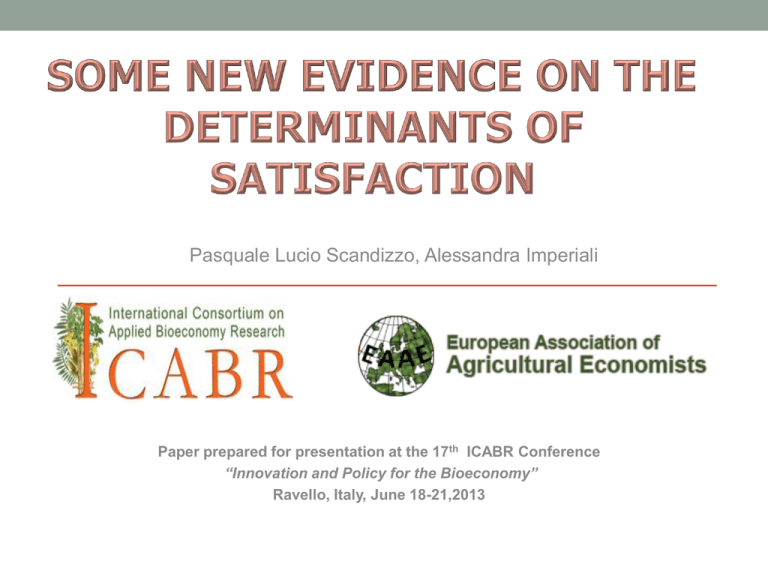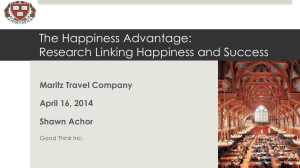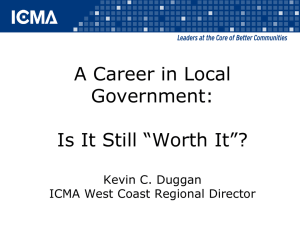Imperiali Alessandra - Facoltà di Economia
advertisement

Pasquale Lucio Scandizzo, Alessandra Imperiali Paper prepared for presentation at the 17th ICABR Conference “Innovation and Policy for the Bioeconomy” Ravello, Italy, June 18-21,2013 18/06/13 Outline Introduction Literature review Data and variables Empirical analysis Concluding remarks 18/06/13 Introduction Aim of this paper • Investigate the link between society’s economic development and average level of subjective well-being. • Account for the effects of environmental attitudes on subjective well-being. • Explore the implications of a model, where environmental variables play a significant effect on human happiness. 18/06/13 Introduction Key Questions • Is happiness research making substantial progress along new lines? • Are there new paradigms for research in the sector which include also the environment? • What is the effect of environment on human happiness? 18/06/13 Literature and review The Happiness Research Recently an intense research activity has been directed towards the study of happiness. In the words of St.Thomas: «Happiness is the ultimate achievement of an intellectual nature» In 2007 Biswas-Diener and Dean defined happiness as: “the experience of frequently mindly pleasant emotions, the relative absence of unpleasant feelings, and a general feeling of satisfaction with one’s life.” (Veenhoven, 1993) 18/06/13 Literature and review The Happiness Research • The first important contribution to the happiness literature was derived by Richard Easterlin who, in several papers examined the relationship between happiness and GDP both across than within countries through time (1974, 1995,2005a) • Starting from 1990, empirical studies on happiness and subjective well-being started to incorporate other diverse fields such as social sciences and politics (Frey and Stutzer 2002,Graham and Helliwell, 2001, Di Tella et al., 1998, 2000, Blanchflower and Oswald, 1998, 2000, Easterlin and Schaeffer, 1999) • In 2002 the psychologist Daniel Kahneman won the Nobel Prize in Economics because he was able to establish a relationship between utility and happiness. 18/06/13 Literature and review The Happiness Research Despite the considerable literature on the economics of happiness, little interest has been devoted to the relationship between environmental attitudes on subjective well-being. Different studies found that climatic variables have a significant effect on subjective well-being (Frijters & Van Praag, 1998; Rehdanz and Maddison, 2005; Brereton et al., 2008) Rehdanz and Maddison (2005) investigated the relationship between climate and happiness. The linkage between air pollution and happiness has been examined by Welsch (2002) using cross-section data for 54 countries, and by Welsch (2006) using a panel data approach. The results point to the fact that air pollution plays a statistically significant role as a predictor of inter-country and inter-temporal differences in subjective well-being. 18/06/13 Literature and review The Happiness Research The same analysis has been performed by Di Tella and MacCulloch, 2008; Van Praag & Baarsma, 2005, who noticed that noise and air pollution has a negative effect on subjective well-being. Ferrer-i-Carbonell and Gowdy (2007) and Rehdanz and Maddison (2008) examined the effect of environmental attitudes on subjective well-being (Smyth and Qian, 2008) The implications of happiness research for policy prescriptions of environmental and research economics have yet to be worked out. 18/06/13 Introduction Our Hypotheses • The considerable literature on the economics of happiness, finds a positive relationship between economic growth and the average level of subjective well-being. • We are interested in extending this analysis to the link between “green growth “ and happiness, with the hypothesis that a positive relationship exists between a positive attitude toward the environment and subjective well-being. This is akin to the so called “ biophilia” hypothesis (Wilson, 1984, Kellert and Wilson, 1995), i.e. that human beings are subconsciously gratified by seeking a connection with the rest of life. • An implication of biophilia is a positive relationship between protected areas, attempts of human beings to coexist peacefully with the nature and the average level of subjective well-being. 18/06/13 Introduction The biophilia hypothesis • The biophilia hypothesis asserts the existence of a fundamental genetically based, human need and propensity to affiliation with life and lifelike processes (Peter H. Kahn, 1997) • According to Wilson (1984) the biophilic instint emerges in emotions and unpredictable fantasies and responses of individuals from early childhood onward. • Kaplan and Kaplan have conducted extensive research on individual’s preferences for different sort of landscapes(1973, 1977, 1983, 1987, 1989, 1992). • Their findings point to the fact that people preferred natural environments more than built environments and built environments with water, trees and other vegetation more than built environments without such features. 18/06/13 Introduction The biophilia hypothesis • Orians and Heerwagen (1992) have drawn on evolutionary theory to frame their research hypothesis on landscape aesthetics • They believe people have a generalized bias toward savanna-like environment. • If this bias exist, then people react positively to savannas even in the absence of direct experience. • Their results supported this hypothesis and the hypothesis was confirmed by the study performed by Balling and Falk (1982) 18/06/13 Introduction The biophilia hypothesis • Ulrich (1993) investigated environmental aesthetic, conducting a study on a psychiatric hospital in Sweden on the effects of the visual representation of nature. • Psychiatric patients responded favorably to wall art that involved nature but reacted negatively to abstract paintings and paintings in which the content was ambiguous and unintelligible. • Other studies were conducted in prisons, dental offices and hospital point to the same effects. • Ulrich(1984) explored the differences in the recovery of patients after visual stimulation of different types of nature picture. • • Their findings suggest that the patients exposed during surgery to the picture of an open nature view experienced much less postoperative anxiety than the control groups and the groups exposed to the other types of pictures 18/06/13 Literature and review The Happiness-Environment Economics Relationships. Source: New Economics Foundations Happy Planet Index, 2012. 18/06/13 Data and variables The Analysis • In the empirical part of our paper we aim to study the relationship between “green” growth and happiness and the effects of environmental attitudes on subjective well-being. • We explore the effects on happiness of environmental actions or attitudes to prevent environmental pollution such as an increases in taxes; or other contributions from income for the environment; • We collected the data of 34 countries from two different sources: The World Value Survey (WVS) and the World Bank . The WVS data were averaged at the country level and then were merged with the country level data file from the WB. 11/04/13 Data and variables The Estimates • 18/06/13 Empirical analysis Variables used for our estimates Dependent variable: Satisfaction All things considered, how satisfied are you with your life as a whole these days? 1= dissatisfied 10= maximally satisfied World Value Survey Income for the Environment (inverted scale) Would give part of my income for the Environment 1=strongly agree 4=strongly disagree World Value Survey Increase in taxes (inverted scale) Increase in Taxes if used to prevent Environmental pollution 1=strongly agree 4=strongly disagree World Value Survey Health (inverted scale) State of Health (subjective) 1=very good 5=very poor World Value Survey Nature (anthrocentrism vsus biocentrism) Human & Nature a) a) b) Human beings should master nature Human beings should coexist with nature World Value Survey 18/06/13 Empirical analysis Variables used for our estimates Satisfaction Env. Economic growth Protecting Environment vs. Economic Growth 1= Protecting Environment 2=Economic growth and creating Jobs 3=Other Answers World Value Survey Terrestrial Protected Areas (%of total land area) World Bank GDP Per capita (costant 2000US$) World Bank Employment Total (%of total labour force) World Bank Inflation Consumer prices (annual %) World Bank Life expectancy at birth Total(years) World Bank 18/06/13 Empirical analysis Variables used for our estimates Satisfaction Dummytime10 Year=1998 Dummytime11 Year=1999 Dummytime12 Year=2000 Dummytime13 Year=2001 Dummycountry2 Country= Argentina Dummycountry3 Country= Australia Dummycountry4 Country=Azerbaijan 18/06/13 Empirical analysis The Estimates Dep. Variable Satisfaction employment Inflation (1) -0.09*** (0.006) Income-environment Health Env-economic growth (3) 7.07*** (1.92) -0.05*** (0.015) -0.05*** (0.015) -0.299*** (0.012) -0.035*** (0.015) 0.05*** (0.02) 0.00 (0.002) 4.68*** (7.27) 0.002*** (0.00) -0.00*** (0.00) GDP Increase Taxes (2) -0.09*** (0.09) Nature (antrhocentrism versus biocentrism) Lifeexpencacy Territorialareas Dummytime10 Dummytime11 Dummytime12 Dummycountry3 Dummycountry4 N R-squared 0.13*** (0.019) 0.010*** (0.001) -0.38*** (0.22) 0.31*** (0.03) 0.02 (0.02) 0.44*** (0.03) Dummytime13 Dummycountry2 -0.32*** (0.008) -0.60 (0.38) 0.58*** (0.24) -0.07 (0.24) 27084 0.0041 0.040 (0.045) 10228 0.02 -0.083*** (0.028) -0.22*** (0.018) -0.56 (0.39) 0.08 (0.31) -0.02 (0.22) 18869 0.02 18/06/13 Concluding remarks Conclusions • Our findings suggests that people in countries with a higher average degree of happiness are also more willing to protect the environment • We also found that the interest in human beings coexisting with nature appears to positively influence subjective well-being. • A positive relationship has been also found between terrestrial protected areas and overall subjective well being. • These results combine with traditional results on income , health, • employment and inflation and appear robust with respect to specifications








